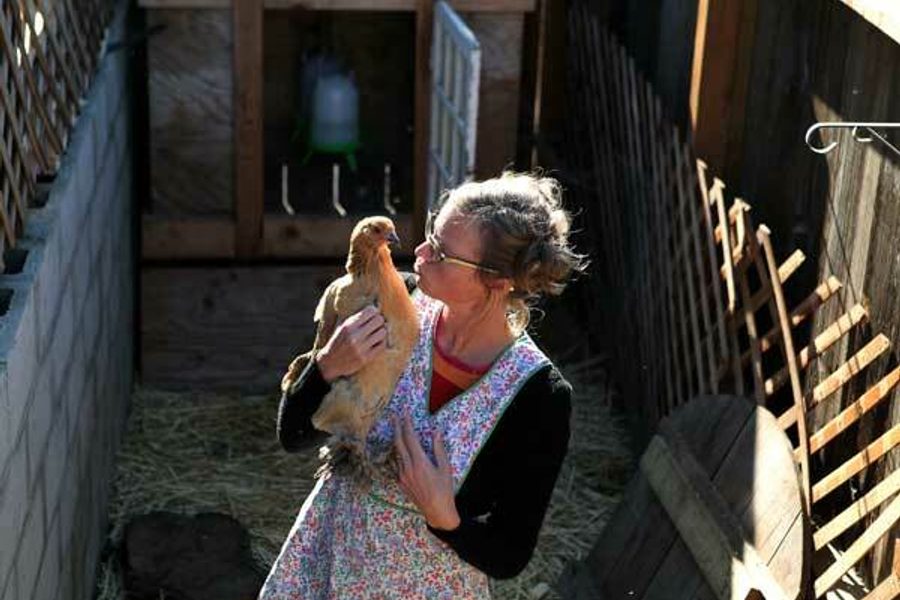Sewage Sludge Everlasting
Alice Waters’ Chez Panisse Foundation jumps on the ‘biosolids’ bandwagon.
Patrick Trahey

With summer approaching, home garden enthusiasts are looking for an efficient way to increase their harvest. And out in the Bay Area, Francesca Vietor is there to help.
Vietor is executive director of the Chez Panisse Foundation, the nonprofit arm of celebrity chef Alice Waters’ natural foods restaurant Chez Panisse. The foundation’s mission is to create “edible schoolyards” where kids grow, prepare and eat food from their own organic gardens.
Vietor is also vice president of the San Francisco Public Utilities Commission (SFPUC), which distributes to local schools, businesses and homeowners what it describes as “organic compost.” The dirty secret is that Vietor’s much-touted compost is made from sewage sludge.
In an investigative report by Anna Werner of San Francisco’s CBS affiliate, the SFPUC defended the practice of distributing the sludge-based fertilizer to schools by citing the fact that it passed EPA standards. But as EPA Senior Analyst and whistleblower Hugh Kaufman points out, “Only 1 percent of the hazardous materials in sludge are regulated.”
Most national and local gardening shops around the country sell sludge-based fertilizers. One option is Milorganite, a fertilizer advertised as “organic biosolids.” Say what?
“Biosolids” is a euphemism for sewage sludge. It was created in the early 1990s by the “Name Change Task Force” of the Water Environment Federation (WEF). Once known as the Federation of Sewage and Industrial Wastes Associations, WEF is the sewage industry’s main lobbying and public-relations organization.
The deceptive wording has not changed one startling fact: Sewage sludge contains hazardous materials, such as dioxins, PCBs, phthalates, brominated flame retardants and toxic heavy metals. But “biosolids” certainly sounds nicer than “toxic waste.” The propaganda campaign was a success: “Biosolids” now appears in the Merriam-Webster dictionary.
In Toxic Sludge Is Good for You, John Stauber and Sheldon Rampton argue that America would have benefited from completely rethinking waste treatment. Beginning in the mid-1800s and continuing today, combined sewer systems – where storm water, household sewage and industrial waste are mixed together – discharge massive amounts of polluted water, most of it “treated,” into rivers, lakes and oceans. When the wastewater is “treated,” toxic sludge – a product of wastewater treatment – is produced. Not putting human waste into the sewer in the first place would have allowed its use as a fertilizer to enrich agricultural soil.
In 1972, riding the wave of new environmental activism, Congress passed the Clean Water Act. The law mandated “upgrades” in sewage treatment. This resulted in expenditures of over $70 billion between 1973 and 1999, but an unforeseen product of the “upgrade” was the near doubling of the production of sewage sludge. The question quickly became: What to do with sludge?
In addition to human excreta, sewage sludge is the byproduct of whatever is put down the drain in hospitals, businesses and factories. Consequently it includes toxic heavy metals, flame retardants, pharmaceutical drugs, hormones, endocrine disruptors, carcinogens and steroids (to name a few possible ingredients).
Rather than recognizing sewage sludge as a dangerous waste product produced by the ton every day in treatment plants, WEF and the EPA sought a quicker solution: re-brand the stuff. Re-branding allowed sewage treatment facilities – like the Milwaukee Metropolitan Sewerage District, which produces Milorganite – to hoodwink the public into thinking hazardous sewage sludge is fertilizer.
The fertilizer distributed in San Francisco by the SFPUC was tested by the Center for Food Safety. It was found to contain, among other hazardous materials, an endocrine disruptor commonly known as DEHP (which has been linked to decreased penis size, decreased semen quality, obesity and testicular tumors). The SFPUC’s own testing revealed toxic chemicals like bisphenol A (BPA), naphthalene and dioxins in its sewage sludge.
But lawn and garden enthusiasts need not travel to San Francisco to disrupt their children’s endocrine levels. Commercially branded sewage sludge is being sold across America, with brands like All-Gro, GroCo, and WeCare Compost joining Milorganite in the sewage scam.
Milorganite is safe for “vegetables and other edible crops,” according to the product’s website. “Children and pets can safely go onto areas that have been fertilized with Milorganite. Milorganite meets the most stringent criteria imposed on any fertilizer product for health, safety and environmental concerns.”
For what it’s worth, Milorganite does meet EPA “exceptional quality” criteria for heavy metals, but since the EPA regulates only heavy metals in sludge, any number of other toxic chemical pollutants could also be in the sludge – and, should you buy it, your garden.
GET INVOLVED:
Organic Consumers Association
I hope you found this article important. Before you leave, I want to ask you to consider supporting our work with a donation. In These Times needs readers like you to help sustain our mission. We don’t depend on—or want—corporate advertising or deep-pocketed billionaires to fund our journalism. We’re supported by you, the reader, so we can focus on covering the issues that matter most to the progressive movement without fear or compromise.
Our work isn’t hidden behind a paywall because of people like you who support our journalism. We want to keep it that way. If you value the work we do and the movements we cover, please consider donating to In These Times.





